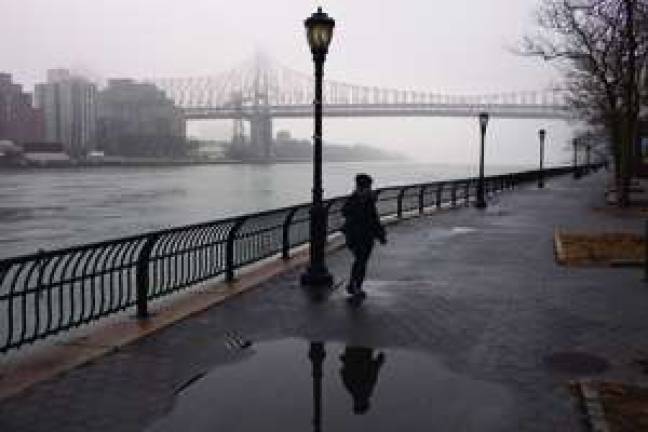Esplanade Update: Assessing Damages and Looking Forward

The East River Esplanade bore some of the worst of Hurricane Sandy's wrath. Stretching from East 60th to 125th Street along the water, the pedestrian walkway was the first area on the Upper East Side to be hit by the storm's tidal surges, before they flooded forward as far as Second Avenue on some streets. Now, two months after the storm, city workers are still assessing the extent of the damages and considering the esplanade's future to determine the best approach to repairs. "When in doubt, assume a section of the esplanade was underwater and covered with debris," said Mark Vaccaro, the Upper East Side's Parks and Recreation manager. He attended a recent Community Board 8 Parks Committee meeting to share what his department has been dealing with since Sandy hit. "You can pretty much assume the plant life along the esplanade is toast," he added. Vaccaro walked the entire esplanade after the storm and took pictures of the sea rails, walking path and flora to catalogue damages. A team of engineers, he said, also rode in a boat alongside the esplanade to inspect its walls. Together, they determined that none of the damage was life-threatening. Small pieces of the capstones between the walkway's seawall and railing were knocked out in 122 places. Several large chunks of the wall itself were stripped off and washed away. At East 66th, 79th and 117th streets, small gaps between the seawall and platform had formed, which, if not repaired before the next instance of flooding, could be filled with water that would push the wall out and collapse parts of the esplanade. Around half of the walkway's trees were dead, he said. The London plane trees were dormant and survived, but the oaks and cherries, along with the walkway's shrubs and grass, were still drawing water and drowned. (Had the storm hit a month later, he noted, plant life would have been much safer, because almost all of it would have been "asleep.") Many lampposts continued to work, but Vaccaro warned that salt water damage to their circuitry meant that "at some point, there are going to be a lot of electrical problems out there." "We really took a huge hit from this storm," he said, noting that more parks in the neighborhood had been closed than in downtown Manhattan. But on the esplanade, he emphasized, "It's not a safety issue. It's a maintenance issue, an issue of repair." What form repairs will take is controversial, because Upper East Siders have been lobbying for an improved waterfront for years. Even before the storm hit, the walkway was riddled with sinkholes and uneven surfaces over sections that were built over 60 years ago. Whether the city will make only superficial repairs or invest in a long-term transformation is a big issue for many community members. "I know this sounds terrible, but I was hoping that the hurricane actually damaged the esplanade to such an extent that the city would have to pay attention to it-without anybody being injured, of course," said Teri Slater, a CB8 member. "What's happening on the esplanade is plastic surgery on a decaying infrastructure." Jane Swanson, chief of staff for Councilwoman Jessica Lappin, agreed that the storm might end up being "a blessing and a curse" for the walkway. "It's an opportunity now," she said at the committee meeting. "I hate to say it that way, but it does force us to look at [the esplanade] and say, 'Hmm, okay, what can we do with regard to making this safe in the event of storms, while also making it a compelling and wonderful place for us to enjoy?'" Swanson said that in order to proceed, however, the board would have to wait for a full engineering study of the esplanade that analyzes the many different ways it was constructed over years of additions and renovations. This study has been in progress and was planned to be finished around the end of the year, but now its projected completion date has been pushed back to February or March because of the storm. "It's hard to provide a big bulk of funding [for a renovation project] if you don't know what that is," Swanson said. She added that after Mayor Michael Bloomberg presents his next preliminary fiscal year budget in January, however, her office will have a better sense of how they can allocate funds to push the project forward.